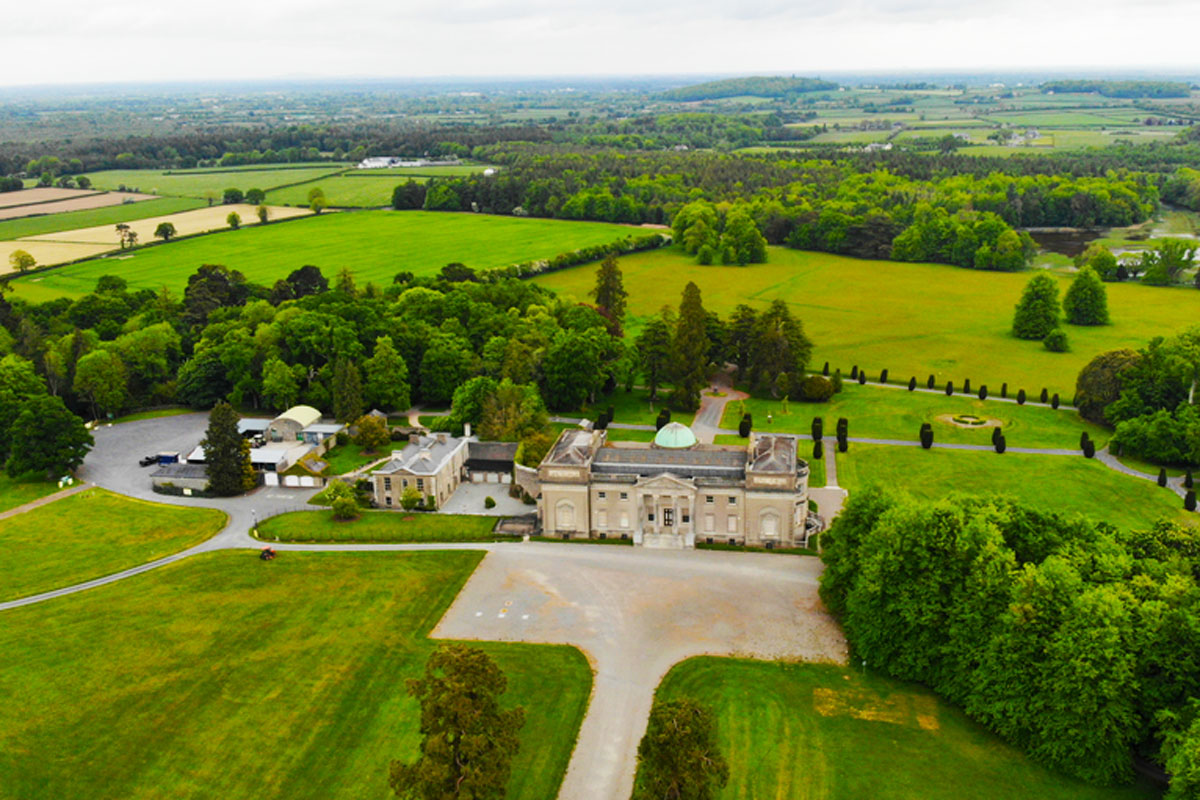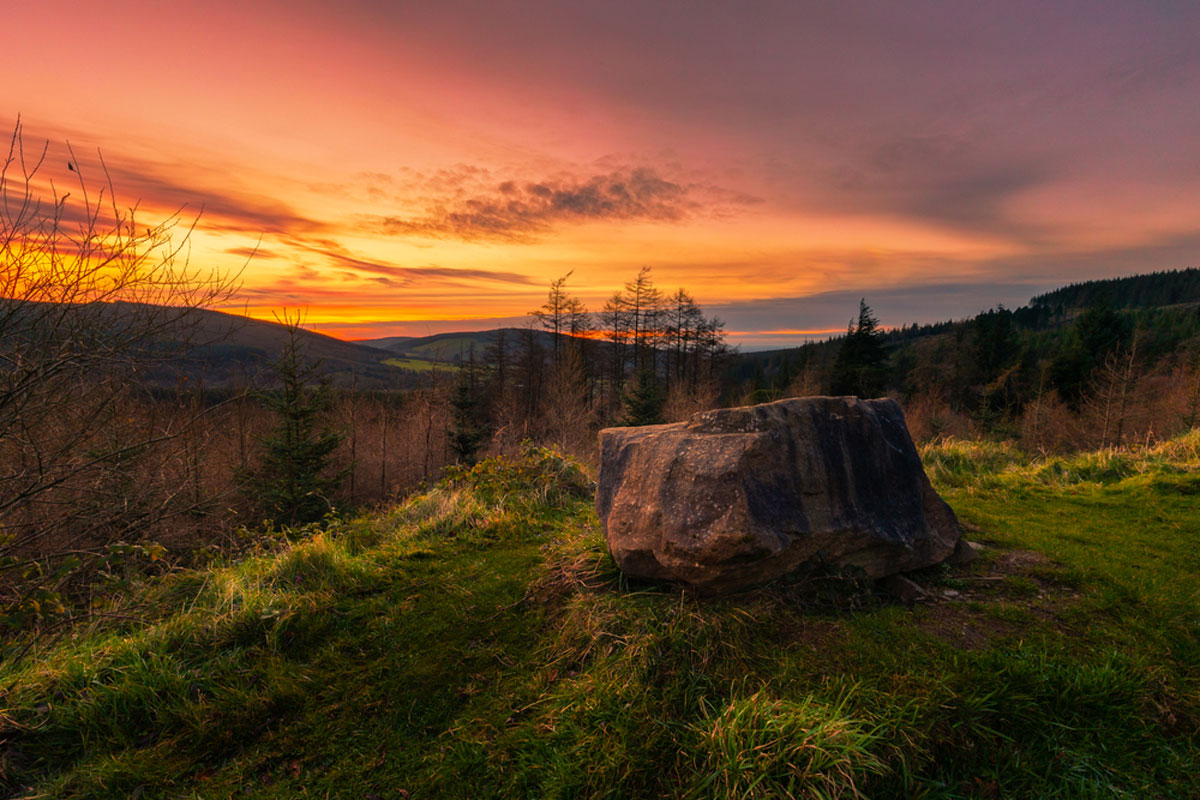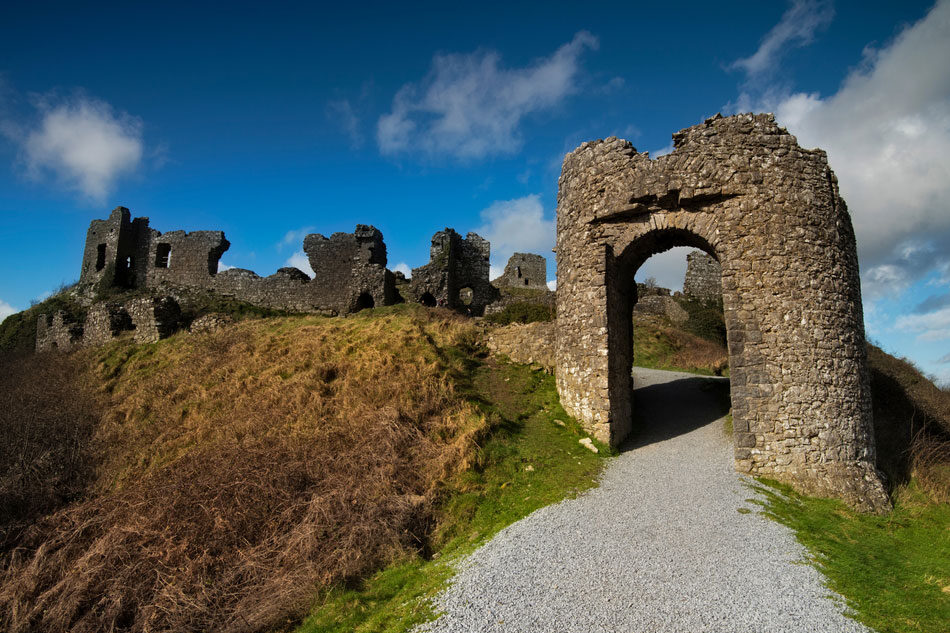The History of Emo Court House
Nestled in the rolling countryside of County Laois, Emo Court House is one of Ireland’s finest neoclassical mansions, steeped in history and surrounded by picturesque gardens and woodlands. This grand estate, designed in the late 18th century, has witnessed centuries of political change, aristocratic grandeur, and cultural evolution.
The Beginnings: A Stately Vision
Emo Court was designed in 1790 by the renowned architect James Gandon, who is best known for Dublin’s Custom House and Four Courts. The mansion was commissioned by John Dawson, 1st Earl of Portarlington, as a grand estate reflecting his family’s wealth and status. Gandon’s vision brought to life an elegant house with a stunning classical portico, grand columns, and symmetrical design, embodying the finest features of Georgian architecture.
The Dawson Family Legacy
For more than a century, the Dawson family resided at Emo Court, expanding the estate and developing its impressive gardens and parklands. The house played host to aristocrats, politicians, and artists, reflecting the opulence of the time. However, like many Irish estates, the fortunes of the family declined in the early 20th century.
A Period of Transition
Following the Irish War of Independence and changing political landscapes, the Dawson family left Emo Court in 1920, marking the end of their era. The house then served various purposes over the years, including a period when it was owned by the Jesuits, who used it as a retreat house.
A New Chapter: The Cholmeley-Harrison Era
In 1969, Emo Court was purchased by Major Cholmeley-Harrison, a British aristocrat with a love for restoring historical buildings. He dedicated decades to meticulously restoring the house and gardens, bringing them back to their former glory. Recognizing the estate’s historical significance, he later donated it to the Irish state in 1994, ensuring its preservation for future generations.
Today’s Emo Court
Now managed by The Office of Public Works (OPW), Emo Court House is open to the public, offering guided tours that take visitors through its magnificent rooms, adorned with period furnishings and artwork. The house stands as a remarkable testament to Ireland’s architectural heritage and its complex past.
The Gardens and Woodlands – A Natural Wonderland
While Emo Court House is a masterpiece of neoclassical architecture, the surrounding gardens and woodlands are equally captivating. Spanning over 250 acres, the estate’s beautifully maintained grounds offer a mix of formal gardens, serene lakes, and enchanting woodland trails, making it one of the most picturesque locations in County Laois.
The Formal Gardens
The formal gardens at Emo Court are designed in the Italianate style, reflecting the elegance and grandeur of the house itself. These manicured gardens, filled with symmetrical flower beds, hedgerows, and classical statues, provide a tranquil setting for visitors. Some highlights include:
- The Walled Garden – Once used to grow vegetables and fruit for the estate, it now features an array of vibrant seasonal flowers.
- The Yew Walk – A striking pathway lined with towering yew trees, offering a shaded retreat in the summer months.
- The Ornamental Fountains – These decorative water features add to the estate’s old-world charm.
The Lake and Parklands
One of the most stunning features of Emo Court’s landscape is its large artificial lake, which reflects the surrounding woodlands and creates a serene, mirror-like effect. Swans and ducks gracefully glide across the water, adding to the peaceful atmosphere. Visitors can enjoy scenic walks around the lake while taking in breathtaking views of the mansion framed by lush greenery.
The Woodlands: A Haven for Nature Lovers
Beyond the formal gardens, the Emo Court woodlands stretch far and wide, providing a natural retreat for walkers, joggers, and families. These ancient forests, filled with towering beech, oak, and redwood trees, change beautifully with the seasons, from vibrant greens in the summer to golden hues in the autumn.
Some must-explore trails include:
- The Beech Walk – A serene path shaded by centuries-old beech trees.
- The Redwood Avenue – Featuring majestic giant redwood trees, some of the tallest in Ireland.
- The Forest Loop – A gentle, scenic trail ideal for a peaceful stroll or a leisurely cycle.
Wildlife lovers will also appreciate the variety of birds, squirrels, and even deer that can occasionally be spotted throughout the estate.
A Perfect Escape
Whether you’re looking for a romantic stroll, a family outing, or a peaceful retreat into nature, Emo Court’s gardens and woodlands offer something for everyone. Visitors can explore at their own pace, take in the seasonal beauty of the flora, or simply sit and enjoy the tranquil atmosphere of this historic estate.
The Architectural Splendor and Interior Treasures
While the gardens and woodlands surrounding Emo Court are a stunning natural escape, the interior of the house is just as captivating. This neoclassical mansion, designed by the renowned architect James Gandon, showcases exquisite craftsmanship, grand halls, and intricate detailing, making it one of the finest stately homes in Ireland.
Neoclassical Grandeur
Emo Court was designed in the late 18th century, following the principles of neoclassical architecture, which was inspired by ancient Greek and Roman styles. Some key architectural highlights include:
- The Grand Facade – The mansion’s exterior features majestic columns, a domed central hall, and a grand entrance, reminiscent of classical temples.
- Symmetry and Proportion – True to the neoclassical style, the house is designed with perfect balance and harmony, creating a timeless elegance.
- The Portico – One of Emo Court’s most iconic features, the large columned portico at the front of the house, provides a dramatic and imposing entrance.
Exploring the Interior
The Rotunda – A Magnificent Central Hall
Upon entering Emo Court, visitors are greeted by the breathtaking Rotunda, a circular room crowned with a domed ceiling. This space is the heart of the mansion, designed to impress guests with its graceful proportions, ornate plasterwork, and classical columns. The Rotunda also serves as a connection to other parts of the house, leading to grand reception rooms.
The Drawing Room – A Space for Aristocratic Gatherings
The Drawing Room, historically used for entertaining guests, exudes sophistication. With large sash windows, decorative ceilings, and period furnishings, this room reflects the luxury and grandeur of the Dawson family, who originally owned the estate.
The Dining Room – A Feast for the Eyes
The Dining Room is one of the most opulent spaces in the house, featuring:
- A long mahogany dining table where aristocrats once dined in style.
- Elaborate chandeliers that illuminate the room with a warm glow.
- Richly decorated walls with intricate moldings and artwork.
The Library – A Literary Sanctuary
For book lovers, the Library at Emo Court is a hidden treasure. Lined with oak bookshelves, this cozy yet elegant room was once a retreat for intellectual discussions and quiet reading.
The Bedrooms and Private Chambers
While some of the private living quarters are not accessible to the public, certain bedrooms have been restored to reflect the Victorian and Georgian influences of their time. These rooms showcase antique furnishings, period wallpapers, and ornate fireplaces, giving a glimpse into the lavish lifestyle of the estate’s former residents.
A Journey Through Time
Emo Court’s interior is a living museum, reflecting the history and changing fortunes of those who once lived here. From its aristocratic grandeur under the Dawsons to its later restoration by Major Cholmeley-Harrison, every room tells a story of elegance, transformation, and preservation.

The People Who Shaped Emo Court’s History
Emo Court’s grandeur and beauty did not come to life on its own—it was shaped by the vision, ambition, and dedication of the people who owned, designed, and restored it. From aristocratic families to renowned architects and passionate restorers, each left their mark on this historic estate.
John Dawson, 1st Earl of Portarlington (1744–1798) – The Visionary Founder
The history of Emo Court begins with John Dawson, 1st Earl of Portarlington, an influential member of the Irish aristocracy. In the late 18th century, he commissioned James Gandon, one of Ireland’s most celebrated architects, to design a grand estate that would reflect his status and wealth.
- Dawson was a member of the Irish Parliament and sought a home that would serve as both a family residence and a symbol of power.
- He envisioned a neoclassical masterpiece, inspired by the grandeur of ancient Greece and Rome.
- Sadly, Dawson did not live to see Emo Court fully completed, passing away in 1798.
James Gandon (1742–1823) – The Architectural Genius
The man responsible for Emo Court’s breathtaking design was James Gandon, one of the most distinguished architects of the Georgian era.
- Gandon was famous for his work on Dublin’s Custom House and Four Courts.
- He brought neoclassical symmetry and elegance to Emo Court, incorporating majestic columns, grand porticos, and a central Rotunda.
- Though his original designs for Emo Court were ambitious, construction progressed slowly and was completed by later generations.
The Dawson Family & Their Legacy
For over a century, Emo Court remained the seat of the Dawson family, particularly the Earls of Portarlington.
- The 2nd and 3rd Earls expanded and refined the house, developing its gardens and parklands.
- By the 20th century, the estate had fallen on hard times due to declining aristocratic wealth and the changing political landscape in Ireland.
- In 1920, the Dawsons abandoned Emo Court, marking the end of their family’s ownership.
The Jesuits (1930–1969) – A Spiritual Retreat
After being unoccupied for a decade, Emo Court found a new purpose when it was acquired by the Jesuit Order in 1930.
- The mansion was transformed into a religious retreat, housing priests and seminarians.
- Many of the grand rooms were repurposed for communal living and study, altering the character of the house.
- Despite this, the Jesuits preserved much of the estate, ensuring it remained structurally intact.
- In 1969, they sold Emo Court, paving the way for its most dedicated restorer.
Major Cholmeley-Harrison (1970–1994) – The Dedicated Restorer
Perhaps the most influential modern figure in Emo Court’s history, Major Cholmeley-Harrison, an English aristocrat, purchased the estate in 1969 and embarked on an ambitious restoration project.
- He painstakingly restored the mansion’s interiors, reviving its neoclassical splendor.
- The gardens were redesigned and landscaped, returning them to their former beauty.
- Understanding the estate’s historical significance, he opened parts of it to the public in the 1990s.
- In 1994, he generously donated Emo Court to the Irish state, ensuring its preservation for future generations.
Today: A National Treasure Managed by the OPW
Today, Emo Court House and Woods is maintained by Ireland’s Office of Public Works (OPW). Thanks to the vision and efforts of architects, aristocrats, religious groups, and restorers, the estate stands as one of Ireland’s most cherished historical landmarks, open for all to explore and enjoy.
Visiting Emo Court Today – A Must-See Destination
After centuries of history, transformation, and restoration, Emo Court House and Gardens has become one of the most treasured attractions in County Laois. Whether you’re a history enthusiast, a nature lover, or simply looking for a peaceful escape, Emo Court offers a perfect blend of heritage, scenic beauty, and outdoor exploration.
Exploring Emo Court House – Guided Tours & Events
The Office of Public Works (OPW) manages Emo Court today, and visitors can step back in time by taking a guided tour of the mansion’s grand interiors. These tours provide insight into:
- The neoclassical architecture designed by James Gandon.
- The stunning Rotunda, a domed central hall that showcases masterful craftsmanship.
- Period furnishings, artwork, and historical exhibits.
- The stories of the families, Jesuits, and restorers who shaped the house over centuries.
Special seasonal events and exhibitions are also held at Emo Court, ranging from art displays to historical talks.
Strolling Through the Gardens and Woodlands
One of the biggest draws to Emo Court is its spectacular gardens and vast woodlands, which provide a tranquil retreat for all visitors. The grounds include:
- The Italianate Formal Gardens – Perfectly manicured hedges, classical statues, and ornamental water features.
- The Walled Garden – A colorful and peaceful spot filled with seasonal flowers.
- The Forest Trails – A variety of walking paths, including The Beech Walk, Redwood Avenue, and the Lake Loop.
- Wildlife Watching – Birds, deer, and red squirrels can often be spotted in the woodlands.
With free public access to the gardens and trails, Emo Court is an ideal place for leisurely walks, photography, and family outings.
The Tea Rooms – A Perfect Spot to Unwind
After exploring the estate, visitors can stop by the charming Tea Rooms located in the former stables. This cozy café serves:
- Freshly baked cakes, scones, and pastries.
- Irish teas and coffees.
- Light lunch options, including soups and sandwiches.
The outdoor seating area offers beautiful views of the estate, making it a perfect place to relax.
Visitor Information – Plan Your Trip
- Location: Emo Court is located just outside Portarlington, County Laois, making it easily accessible from Dublin, Kilkenny, and the Midlands.
- Opening Hours: The gardens and walking trails are open year-round, while the house is open for guided tours during the tourist season.
- Entry Fees:
– Gardens & Woodlands: Free access.
– House Tours: Ticketed entry (check OPW website for up-to-date pricing). - Parking: Free parking is available on-site.
- Facilities: Toilets, picnic areas, and a visitor center are available.
Why Emo Court Should Be on Your Travel List
With its rich history, stunning architecture, breathtaking gardens, and peaceful woodlands, Emo Court is a must-visit destination in County Laois. Whether you’re coming for a historical tour, a scenic walk, or a relaxing afternoon at the Tea Rooms, it’s a place where Ireland’s past and natural beauty come together in perfect harmony.
Natural Attractions
- The Rock of Dunamase – A historic hilltop fort offering stunning views and a glimpse into medieval Ireland.
- Slieve Bloom Mountains – A haven for hikers and nature lovers, with trails, waterfalls, and wildlife.
- Emo Court and Parklands – A grand 18th-century mansion surrounded by beautiful gardens and woodland walks.
- Glenbarrow Waterfall – A scenic spot in the Slieve Bloom Mountains, perfect for photography and picnics.
- Lough Boora Discovery Park – Nearby, offering trails, sculptures, and birdwatching opportunities.
Historical and Cultural Sites
- Timahoe Round Tower – A well-preserved 12th-century tower in a picturesque village setting.
- Donaghmore Workhouse and Agricultural Museum – A museum exploring the history of Ireland’s workhouses and farming traditions.
- Abbeyleix Heritage House – Showcasing the rich history of one of Ireland’s oldest planned towns.
- Heywood Gardens – Designed by Sir Edwin Lutyens, featuring formal gardens and a stunning lake.
- Portlaoise Heritage Trail – A self-guided walking tour through the town’s historic sites.
Unique Experiences
- Stradbally Steam Museum – A fascinating collection of steam engines and memorabilia.
- Electric Picnic Festival – An annual music and arts festival attracting international acts and visitors.
- Roundwood House – A charming Georgian country house offering accommodation and cooking experiences.
- Ballykilcavan Brewery – A family-run brewery offering tours and tastings of craft beers.
- Cullahill Mountain Walk – A moderate hike with panoramic views of the surrounding countryside.
Scenic Villages and Drives
- Abbeyleix – A charming heritage town with boutique shops, cafes, and historical landmarks.
- Durrow – Known for its craft fairs and the annual Scarecrow Festival.
- Mountmellick – Famous for Mountmellick embroidery and its dedicated museum.
- Stradbally – A picturesque village hosting the National Steam Rally and Electric Picnic.
- Rosenallis – A quaint village near the Slieve Bloom Mountains, ideal for outdoor enthusiasts.
Outdoor Activities
- Slieve Bloom Way – A long-distance walking route through diverse landscapes.
- Fishing on River Barrow – Ideal for anglers seeking tranquility and abundant fish stocks.
- Golf at The Heritage – A championship golf course designed by Seve Ballesteros.
- Cycling Trails – Explore Laois’ scenic countryside on two wheels.
County Laois offers a blend of natural beauty, historical treasures, and vibrant cultural experiences, making it an excellent destination for visitors of all interests.
Helpful Resources






